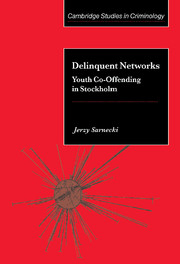Book contents
- Frontmatter
- Contents
- List of figures
- List of tables
- Acknowledgements
- 1 Social Network Analysis and Criminology
- 2 The Aims and Method of the Study
- 3 Actors and Links
- 4 The Choice of Co-offenders.
- 5 The Network
- 6 The Network Connections of Juveniles Admitted to Secure Care Facilities
- 7 Football Hooligans in the Networks
- 8 Politically and Ideologically Motivated Offences
- 9 Ethnicity
- 10 The ‘Ängen Gang’
- 11 Conclusions
- Appendix
- Notes
- References
- Index
2 - The Aims and Method of the Study
Published online by Cambridge University Press: 08 October 2009
- Frontmatter
- Contents
- List of figures
- List of tables
- Acknowledgements
- 1 Social Network Analysis and Criminology
- 2 The Aims and Method of the Study
- 3 Actors and Links
- 4 The Choice of Co-offenders.
- 5 The Network
- 6 The Network Connections of Juveniles Admitted to Secure Care Facilities
- 7 Football Hooligans in the Networks
- 8 Politically and Ideologically Motivated Offences
- 9 Ethnicity
- 10 The ‘Ängen Gang’
- 11 Conclusions
- Appendix
- Notes
- References
- Index
Summary
The aims of the study
In the previous chapter, I have attempted to show that the network perspective is closely tied to criminological theory, even if it is seldom used in empirical criminological studies. What is interesting is that the network approach, in a methodological sense at least, is compatible with a number of different and often conflicting perspectives within criminological theory. The conclusion reached at the end of my (necessarily brief) discussion is that a study of juvenile offending in a metropolitan area which employs network methods may well contribute with new insights into this form of criminality. The network analyses employed in this study build primarily on the concept of co-offending.
The intention here is to use network methodology to examine the structure of co-offending and the formation of juvenile crime networks in a metropolitan area. The hope is that our understanding of juvenile crime will be improved when we examine not only the criminally active individuals themselves but also the relationships that exist among them.
In this context there is no reason to hide the fact that the organisation of the study is in large part governed by the possibilities and limitations associated with the need to gain access to relevant data.
Issues to be examined
The study will look at the following specific questions:
What do the co-offending networks formed by youths in Stockholm look like? (A central network as was the case in Borlänge? A number of central groups? A more splintered structure?)
How stable are relations between co-offenders and how durable are the delinquent networks?
[…]
- Type
- Chapter
- Information
- Delinquent NetworksYouth Co-Offending in Stockholm, pp. 29 - 36Publisher: Cambridge University PressPrint publication year: 2001

